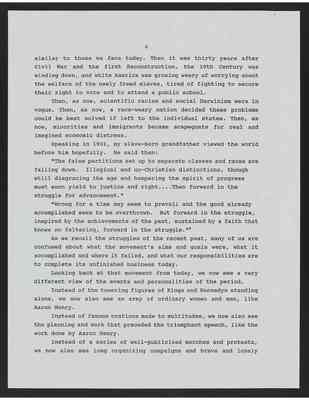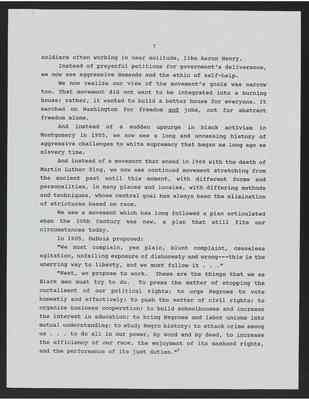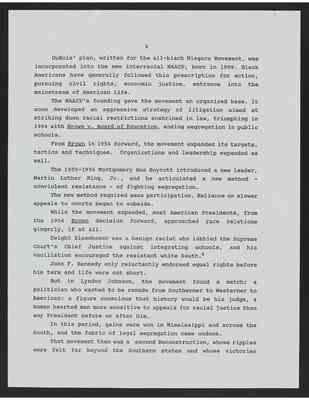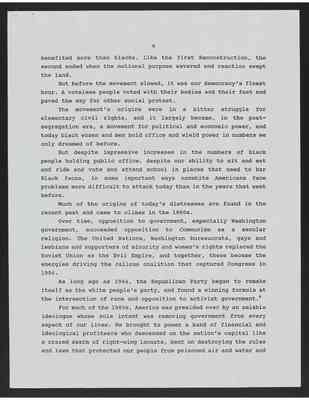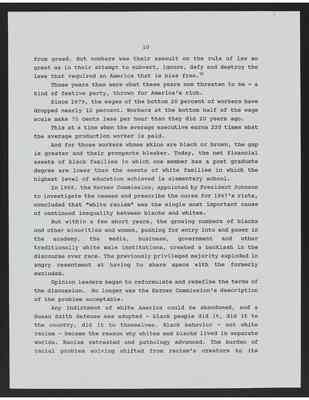Pages
6
6 similar to those we face today. Then it was thirty years after Civil War and the first Reconstruction, the 19th Century was winding down, and white America was growing weary of worrying about the welfare of the newly freed slaves, tired of fighting to secure their rights to vote and to attend a public school.
Then, as now, scientific racism and social Darwinism were in vogue. Then, as now, a race-weary nation decided these problems could be best solved if left to the individual states. Then, as now, minorities and immigrants became scapegoats for real and imagined distress.
Speaking in 1901, my slave-born grandfather viewed the world before him hopefully. He said then:
"The false partitions set up to separate classes and races are falling down. Illogical and un-Christian distinctions, though still disgracing the age and hampering the spirit of progress must soon yield to justice and right .... Then forward in the struggle for advancement."
"Wrong for a time may seem to prevail and the good already accomplished seem to be overthrown. But forward in the struggle, inspired by the achievements of the past, sustained by a faith that knows no faltering, forward in the struggle."6
As we recall the struggles of the recent past, many of us are confused about what the movement's aims and goals were, what it accomplished and where it failed, and what our responsibilities are to complete its unfinished business today.
Looking back at that movement from today, we now see a very different view of the events and personalities of the period.
Instead of the towering figures of Kings and Kennedys standing alone, we now also see an army of ordinary women and men, like Aaron Henry.
Instead of famous orations made to multitudes, we now also see the planning and work that preceded the triumphant speech, like the work done by Aaron Henry.
Instead of a series of well-publicized marches and protests, we now also see long organizing campaigns and brave and lonely
7
7 soldiers often working in near solitude, like Aaron Henry.
Instead of prayerful petitions for government's deliverance, we now see aggressive demands and the ethic of self-help.
We now realize our view of the movement's goals was narrow too. That movement did not want to be integrated into a burning house; rather, it wanted to build a better house for everyone. It marched on Washington for freedom and jobs, not for abstract freedom alone.
And instead of a sudden upsurge in black activism in Montgomery in 1955, we now see a long and unceasing history of aggressive challenges to white supremacy that began as long ago as slavery time.
And instead of a movement that ended in 1968 with the death of Martin Luther King, we now see continued movement stretching from the ancient past until this moment, with different forms and personalities, in many places and locales, with differing methods and techniques, whose central goal has always been the elimination of strictures based on race.
We see a movement which has long followed a plan articulated when the 20th Century was new, a plan that still fits our circumstances today.
In 1905, DuBois proposed: "We must complain, yes plain, blunt complaint, ceaseless agitation, unfailing exposure of dishonesty and wrong --- this is the unerring way to liberty, and we must follow it . . ."
"Next, we propose to work. These are the things that we as Black men must try to do. To press the matter of stopping the curtailment of our political rights; to urge Negroes to vote honestly and effectively; to push the matter of civil rights; to organize business cooperation; to build schoolhouses and increase the interest in education; to bring Negroes and labor unions into mutual understanding; to study Negro history; to attack crime among us . . . to do all in our power, by word and by deed, to increase the efficiency of our race, the enjoyment of its manhood rights, and the performance of its just duties."7
8
8 DuBois' plan, written for the all-black Niagara Movement, was incorporated into the new interracial NAACP, born in 1909. Black Americans have generally followed this prescription for action, pursuing civil rights, economic justice, entrance into the mainstream of American life.
The NAACP's founding gave the movement an organized base. It soon developed an aggressive strategy of litigation aimed at striking down racial restrictions enshrined in law, triumphing in 1954 with Brown v. Board of Education, ending segregation in public schools.
From Brown in 1954 forward, the movement expanded its targets, tactics and techniques. Organizations and leadership expanded as well.
The1955-1956 Montgomery Bus Boycott introduced a new leader, Martin Luther King, Jr., and he articulated a new method - nonviolent resistance - of fighting segregation.
The new method required mass participation. Reliance on slower appeals to courts began to subside.
While the movement expanded, most American Presidents, from the 1954 Brown decision forward, approached race relations gingerly, if at all.
Dwight Eisenhower was a benign racist who lobbied the Supreme Court's Chief Justice against integrating schools, and his vacillation encouraged the resistant white South.8
John F. Kennedy only reluctantly endorsed equal rights before his term and life were cut short.
But in Lyndon Johnson, the movement found a match; a politician who wanted to be remade from Southerner to Westerner to American; a figure conscious that history would be his judge, a human hearted man more sensitive to appeals for racial justice than any President before or after him.
In this period, gains were won in Mississippi and across the South, and the fabric of legal segregation came undone.
That movement then was a second Reconstruction, whose ripples were felt far beyond the Southern states and whose victories
9
9
benefited more than blacks. Like the first Reconstruction, the second ended when the national purpose wavered and reaction swept the land.
But before the movement slowed, it was our democracy's finest hour. A voteless people voted with their bodies and their feet and paved the way for other social protest.
The movement's origins were in a bitter struggle for elementary civil rights, and it largely became, in the post-segregation era, a movement for political and economic power, and today black women and men hold office and wield power in numbers we only dreamed of before.
But despite impressive increases in the numbers of black people holding public office, despite our ability to sit and eat and ride and vote and attend school in places that used to bar Black faces, in some important ways nonwhite Americans face problems more difficult to attack today than in the years that went before.
Much of the origins of today's distresses are found in the recent past and came to climax in the 1980s.
Over time, opposition to government, especially Washington government, succeeded opposition to Communism as a secular religion. The United Nations, Washington bureaucrats, gays and lesbians and supporters of minority and women's rights replaced the Soviet Union as the Evil Empire, and together, these became the energies driving the callous coalition that captured Congress in 1994.
As long ago as 1964, the Republican Party began to remake itself as the white people's party, and found a winning formula at the intersection of race and opposition to activist government.9
For much of the 1980s. America was presided over by an amiable ideologue whose sole intent was removing government from every aspect of our lives. He brought to power a band of financial and ideological profiteers who descended on the nation's capital like a crazed swarm of right-wing locusts, bent on destroying the rules and laws that protected our people from poisoned air and water and
10
10
from greed. But nowhere was their assault on the rule of law so great as in their attempt to subvert, ignore, defy and destroy the laws that required an America that is bias free.10
Those years then were what these years now threaten to be - a kind of festive party, thrown for America's rich.
Since 1979, the wages of the bottom 20 percent of workers have dropped nearly 12 percent. Workers at the bottom half of the wage scale make 75 cents less per hour than they did 20 years ago.
This at a time when the average executive earns 220 times what the average production worker is paid.
And for those workers whose skins are black or brown, the gap is greater and their prospects bleaker. Today, the net financial assets of black families in which one member has a post graduate degree are lower than the assets of white families in which the highest level of education achieved is elementary school.
In 1968, the Kerner Commission, appointed by President Johnson to investigate the causes and prescribe the cures for 1967's riots, concluded that "white racism" was the single most important cause of continued inequality between blacks and whites.
But within a few short years, the growing numbers of blacks and other minorities and women, pushing for entry into and power in the academy, the media, business, government and other traditionally white male institutions, created a backlash in the discourse over race. The previously privileged majority exploded in angry resentment at having to share space with the formerly excluded.
Opinion leaders began to reformulate and redefine the terms of the discussion. No longer was the Kerner Commission's description of the problem acceptable.
Any indictment of white America could be abandoned, and a Susan Smith defense was adopted - black people did it, did it to the country, did it to themselves. Black behavior - not white racism - became the reason why whites and blacks lived in separate worlds. Racism retreated and pathology advanced. The burden of racial problem solving shifted from racism's creators to its
